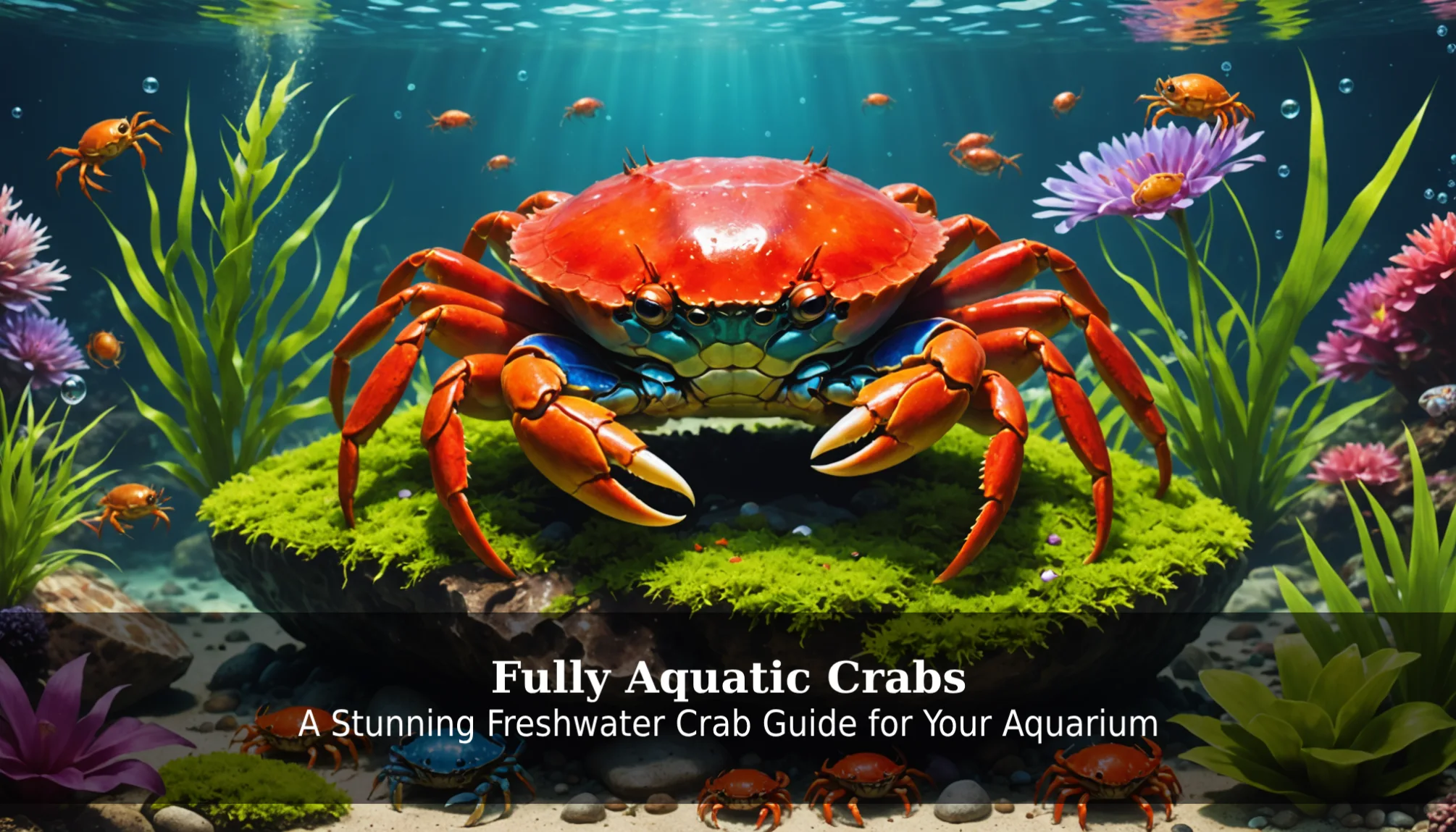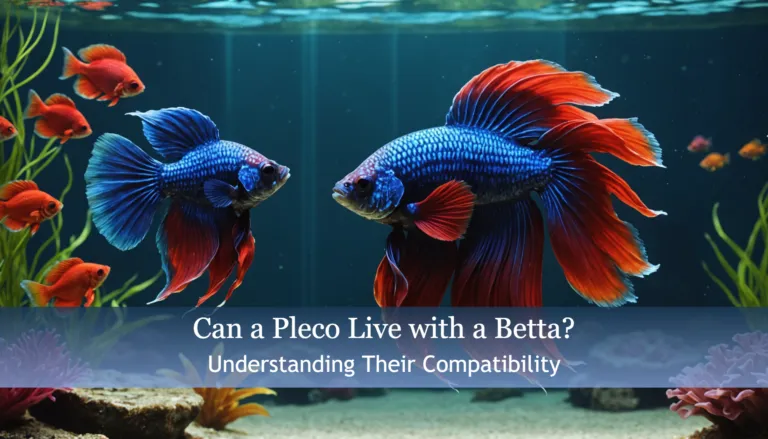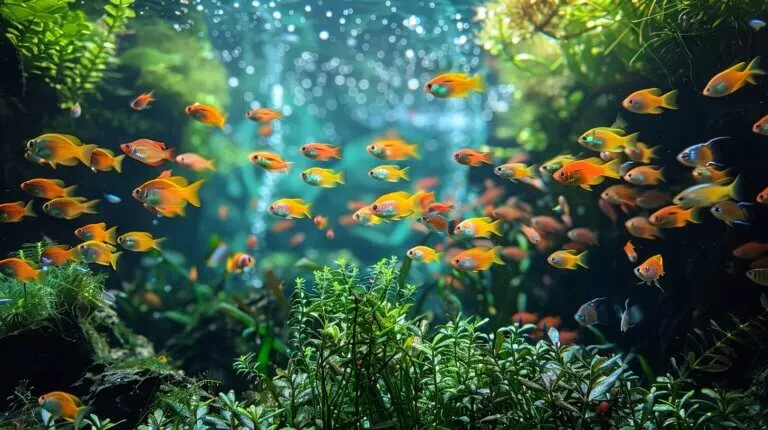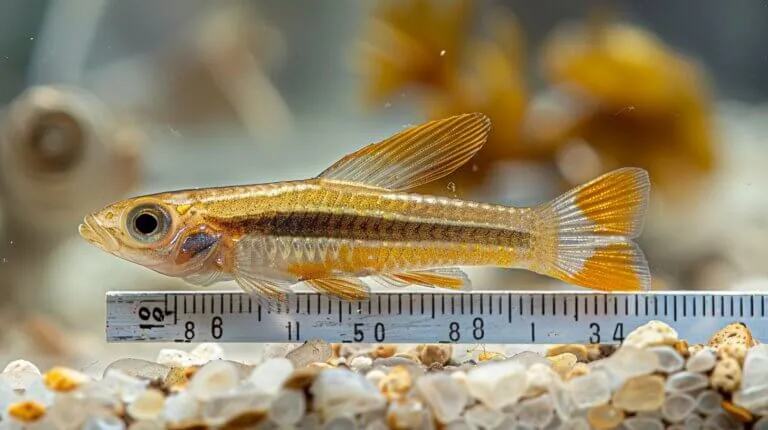Imagine a creature that can transform your freshwater aquarium into a vibrant underwater kingdom! Fully aquatic crabs can bring a splash of color and excitement to your tank, but they’re more than just pretty faces. These fascinating crustaceans are not only fun to watch, but they also play a crucial role in keeping your aquarium healthy. Learning how to care for them is essential, as failing to provide the right environment could lead to unhappy crabs and a less lively tank.
In this ultimate guide, you’ll discover the most popular freshwater crab species perfect for beginners, tips on setting up an aquarium, and how to maintain optimal water conditions. We’ll also cover the necessary hiding spots these little scavengers need to thrive. So, if you’re ready to dive into the world of fully aquatic crabs, keep reading to find out how to make your aquarium a stunning haven for these incredible creatures!
Ultimate Guide to Keeping Freshwater Crabs in Your Aquarium

Most Popular Freshwater Crab Species for Beginners
Fully aquatic crabs add a stunning new element to freshwater tanks. Four species stand out as the best choices for those just starting out. The Thai Micro Crab stays tiny and moves with gentle grace. Red Claw Crabs show off bright colors that catch the eye. Fiddler Crabs, with their one large claw, create unique shapes in the tank. Vampire Crabs display rich purple bodies that look amazing against green plants.
These crabs need the right home to stay healthy. Each species prefers certain water conditions. Some need warmer water, while others like more hiding spots.
The right first crab makes all the difference for new owners. Picking a crab that matches your tank size and setup leads to better success. Before buying any crab, learn what that species needs to thrive.
How to Setup a Freshwater Aquarium for Crabs
Creating the perfect home for fully aquatic crabs starts with the right tank setup. Crabs need places to hide, proper substrate, and clean water. A good setup includes caves made from rocks or driftwood. Plants like Java moss or Anubias add natural hiding spots that make crabs feel safe.
For the bottom of the tank, sand works best for most crab species. It lets them dig and burrow as they would in nature. This natural behavior helps reduce stress in captive crabs.
Water quality matters most for crab health. Most freshwater crabs prefer temperatures between 23-28°C (73-82°F) and a pH range of 7.0 to 8.0. Testing water weekly helps catch problems before crabs get sick.
Research shows that stable water conditions prevent many health issues in crabs. When water stays clean and consistent, crabs show more natural behaviors and live longer.
Why Freshwater Crabs for Aquariums Make Excellent Pets
Freshwater crabs bring unique movement and color to aquariums. Unlike fish that swim back and forth, crabs climb, dig, and explore their space. This creates constant interest for people watching the tank.
The Vampire Crab stands out with its striking colors and is often sought after for its beauty in aquariums. Their deep purple shells with bright orange legs create a stunning display against green plants.
Crabs also show interesting behaviors. They use their claws to pick up food, fight for territory, or build small homes in the substrate. These actions make them more interactive than many fish species.
Research indicates growing interest in keeping freshwater crabs as pets due to their unique behaviors and vibrant appearances. As more people learn about these fascinating creatures, their popularity continues to rise in the hobby.
How to Keep Freshwater Crabs Healthy in Captivity

Essential Water Parameters Crabs Need to Thrive
Water quality forms the foundation of crab health in captivity. Most freshwater crabs need specific conditions to stay healthy and active. The right water parameters prevent stress and disease.
Temperature should stay between 23-28°C (73-82°F) for most crab species. This range supports normal metabolism and activity. Sudden temperature changes cause stress, so use a reliable heater with a thermostat. (Science Direct)
The pH level matters just as much as temperature. A range of 7.0 to 8.0 works best for most freshwater crab species. Test pH weekly to catch any shifts before they harm your crabs.
| Water Parameter | Ideal Range | Why It Matters |
|---|---|---|
| Temperature | 23-28°C (73-82°F) | Supports normal metabolism |
| pH | 7.0-8.0 | Creates stable environment |
| Ammonia | 0 ppm | Toxic even in small amounts |
| Nitrite | 0 ppm | Harms gill function |
| Nitrate | Below 20 ppm | Lower is better for long-term health |
| Water hardness | Species-specific | Affects molting success |
Studies show that keeping these parameters stable prevents most health problems in crabs. Even small changes can cause stress that leads to bigger issues over time.
Proper Diet to Maintain Your Crab Healthy
Freshwater crabs need a varied diet to stay healthy and colorful. As omnivores, they eat both plant matter and protein foods. A balanced approach ensures they get all needed nutrients. (Wikipedia)
Good food choices include:
- Commercial crab pellets as a base diet
- Blanched vegetables like spinach and zucchini
- Frozen foods such as bloodworms or brine shrimp
- Algae wafers for plant nutrition
Many aquarists recommend using a combination of live and dried foods to ensure crabs receive necessary nutrients. Live foods trigger natural hunting behaviors, while prepared foods provide consistent nutrition. (Science Direct)
Feed small amounts once daily, removing any leftover food after a few hours. Overfeeding leads to poor water quality that harms crab health. Watch how much your crabs eat and adjust portions as needed.
Diet directly affects shell color, molting success, and activity levels in crabs. A crab with a proper diet shows bright colors and regular, successful molts.
Common Health Issues Every Crab Owner Should Recognize
Spotting health problems early helps keep crabs thriving in home aquariums. Three main issues affect captive crabs: stress, molting problems, and escape attempts. Each shows specific signs that alert owners to take action.
Stress often appears first as hiding more than usual. A stressed crab may stop eating or show less activity during normal active periods. Poor water quality causes most stress cases in aquarium crabs. (Wiley Online Library)
Molting problems happen when crabs struggle to shed their old shell. Signs include:
- Getting stuck in the old shell
- Missing limbs after molting
- Soft shell that doesn’t harden properly
- Death during or shortly after molting
Escape attempts signal something wrong with tank conditions. Crabs that constantly try to climb out need better water quality or more hiding spots. A secure lid prevents loss while you fix the underlying issues.
Research indicates that maintaining stable water parameters is essential for preventing stress-related health issues in crabs. Regular water testing helps catch problems before they affect crab health.
Creating Proper Hiding Spots in Your Freshwater Aquarium
Hiding places serve as must-have features in any crab aquarium. Aquarists emphasize the importance of adding hiding spots to reduce stress, as crabs are naturally shy creatures. These safe spaces let crabs retreat when they feel threatened.
Effective hiding options include:
- Small caves made from rocks or driftwood
- Dense plants like Java moss or Anubias
- Coconut shells with doorway holes cut out
- Commercial aquarium decorations with hollow spaces
- PVC pipe sections buried in substrate
Place hiding spots throughout different tank levels. Some crabs prefer the bottom, while others climb to higher spots. Having options at various heights meets the needs of different species.
Studies show that crabs with adequate hiding places display more natural behaviors. They spend less time stressed and more time exploring, feeding, and interacting with their environment. Multiple hideouts also reduce fighting over territory among crabs. (NCBI)
Best Crab Species for the Freshwater Aquarium Enthusiast

Thai Micro Crab
The Thai Micro Crab lives up to its name with a tiny body reaching just 1 centimeter wide. These small crabs move with delicate steps through plants and decor. Their size makes them perfect for nano tanks of 5 gallons or more.
These peaceful crabs won’t harm fish or plants. They spend most time picking tiny food bits from plants and surfaces. Their brownish-gray color helps them blend with natural tank elements.
Thai Micro Crabs need stable, clean water with temperatures between 23-26°C (73-79°F). They prefer slightly acidic to neutral pH levels around 6.5-7.5. Their small size means they produce little waste compared to larger crab species.
These tiny crabs eat biofilm, algae, and small food particles. Feed them crushed flakes, powdered foods, or baby shrimp foods to match their small size. Their gentle nature and tiny size make them good additions to peaceful community tanks.
Red Claw Crabs
Red Claw Crabs catch the eye with bright red claws and legs against their brown bodies. These active crabs grow to about 2-3 inches across. They constantly explore their environment with curious movements.
These crabs need brackish water conditions—a mix of fresh and marine water. A specific gravity between 1.005-1.010 creates the right salt level. They also need land areas above water where they can climb and rest.
Red Claw Crabs eat various foods including:
- Commercial crab pellets
- Blanched vegetables
- Frozen bloodworms or brine shrimp
- Algae wafers
These crabs show some territorial behavior, especially toward other crabs. They need plenty of space and multiple hiding spots to reduce fighting. Their climbing skills mean tanks need secure, tight-fitting lids to prevent escape.
Despite care challenges, their striking appearance and active nature make them popular with dedicated crab keepers. Their bright colors create a stunning display in properly set up brackish tanks.
Fiddler Crabs
Fiddler Crabs stand out with the male’s one oversized claw, which can be as large as his body. This claw serves for display rather than feeding. Males wave this large claw to attract females and warn away rivals.
These crabs need brackish water with marine salt added to freshwater; they also require land areas where they can completely leave the water—a sloped beach area in the tank meets this need.
Fiddler Crabs reach about 2 inches across and come in various colors; they feed by picking through substrate with their small claws, filtering out food particles; in tanks, they eat:
- Algae wafers
- Crushed pellet foods
- Frozen foods like bloodworms
- Vegetable matter
These crabs need excellent water quality despite their tough appearance; regular water changes keep their brackish environment clean and stable; multiple males may fight for territory, so provide enough space if keeping several.
Their unique appearance and interesting waving behavior make them fascinating to watch; the proper habitat with both land and water areas creates a stunning display of natural crab behavior.
Vampire Crabs
Vampire Crabs earn their name from their striking purple color and somewhat spooky appearance; their deep purple shells often pair with bright orange or yellow legs creating one of the most stunning displays in the crab world.
These crabs reach about 1-2 inches across when fully grown; they prefer freshwater conditions with plenty of land areas—a tank with 30% water and 70% land creates their ideal habitat.
Vampire Crabs come from Indonesia and need warm temperatures between 75-82°F (24-28°C); they thrive in humid environments with plenty of plants and hiding spots; live plants like pothos, ferns, and mosses help maintain humidity.
These crabs eat an omnivorous diet including:
- Small insects and worms
- Fish food pellets
- Blanched vegetables
- Commercial crab foods
Vampire Crabs often breed in captivity when kept in proper conditions; females carry eggs until they hatch into tiny fully formed crabs—this makes them slightly easier to breed than those with complex larval stages.
Their stunning colors and interesting behaviors make them highly sought after for display aquariums; when properly kept, they create a truly stunning addition to specialized freshwater setups.
Essential Knowledge All Freshwater Crab Owners Need

What Crabs Need for Proper Molting
Molting marks a critical time in every crab’s life; during this process, crabs shed their old shell and grow a new larger one; proper conditions during molting directly affect crab survival and health.
Signs a crab will molt soon include:
- Hiding more than usual
- Slowing down activity and eating less
- Color changes in the shell (often becoming duller)
- Small cracks appearing along the back edge of the shell
Calcium plays a key role in successful molting; adding calcium sources to the tank helps crabs build strong new shells—crushed coral, cuttlebone pieces, or commercial calcium supplements work well for this purpose.
After molting, crabs have soft new shells that harden over several days; during this time, they stay hidden to avoid predators; extra hiding spots protect molting crabs from tank mates who might attack them when vulnerable.
Research shows that molting problems rank among the most common health issues for captive crabs; water quality diet, and stress levels all affect molting success; maintaining stable conditions gives crabs the best chance for successful molts.
How to Prevent Escape: Securing Your Aquarium
Crabs often try to escape from tanks that don’t meet their needs; their strong claws and climbing skills make them excellent escape artists—a secure tank setup prevents loss while keeping crabs safe.
Key escape prevention measures include:
- Tight-fitting lids with no gaps
- Covered filter openings and cable entry points
- No decorations that reach all the way to the top
- At least 2-3 inches between water surface and lid
Some species like Red Claw Crabs and Fiddler Crabs actively seek land areas; for these crabs, create proper land zones inside the tank—this meets their natural needs and reduces escape attempts.
If crabs keep trying to escape despite a secure lid, check water parameters; poor water quality often drives escape behavior—test for ammonia nitrite and proper pH levels to find possible problems.
Studies show that escaped crabs rarely survive long outside of water or in improper conditions—prevention through proper tank setup remains the best approach to keeping crabs safe and secure.
Signs Your Freshwater Crab is Stressed
Stress in crabs leads to health problems if not addressed quickly; knowing the signs helps owners take action before serious issues develop—crabs cannot tell us when something is wrong, so we must watch for behavior changes.
Common stress signals include:
- Hiding excessively (more than normal for the species)
- Refusing food for multiple days
- Erratic movement patterns or unusual activity levels
- Aggressive behavior toward tank mates
- Constant attempts to climb tank walls
Research indicates that maintaining stable water parameters is essential for preventing stress-related health issues in crabs; regular testing helps catch problems early before crabs show stress symptoms.
When stress signs appear, check water quality first—ammonia nitrite or extreme pH levels cause most stress cases in aquarium crabs; water changes often quickly improve conditions by alleviating poor water quality concerns.
Treating stress early prevents more serious problems like disease or death; regular observation helps catch subtle changes in behavior that signal emerging issues.
Best Tank Mates for a Community Freshwater Aquarium with Crabs
Choosing the right tank mates creates a peaceful community with crabs; while some species can coexist peacefully, careful selection is essential to avoid aggression and territorial disputes.
Good tank mates for freshwater crabs include:
- Larger peaceful fish that swim in middle to upper water
- Fast-moving species that avoid crab claws
- Snails with thick shells
- Similar-sized peaceful crab species (for some species)
Fish to avoid keeping with crabs include:
- Small bottom-dwellers that compete for space
- Long-finned species that might get caught in claws
- Aggressive or territorial fish
- Very small fish that might become crab food
Tank size greatly affects compatibility success; larger tanks create more territory for all creatures while reducing conflicts significantly.
Creating distinct zones within your tank helps different species find their preferred areas without crowding each other out too much over time.
Advanced Tips for the Dedicated Crab Owner

Breeding Freshwater Crabs in Home Aquariums
Breeding freshwater crabs at home is challenging due to specific environmental needs required during mating periods along with potential territorial disputes among males competing over females’ attention during breeding times!
Creating an Ideal Breeding Environment:
- Research your specific species’ breeding requirements thoroughly before attempting anything!
- Provide appropriate breeding conditions tailored specifically towards whatever type you own (e.g., temperature adjustments).
- Ensure good nutrition is available leading up until mating occurs—this often involves increasing protein intake prior!
Critical Factors:
- Water Quality: Maintain optimal pH & salinity levels.
- Reduce Stress: Minimize disturbances during mating.
- Provide Hiding Spaces: Allow females somewhere safe while carrying eggs.
- Monitor Progress: Regularly check on any developing eggs/larvae post-hatching!
Successful breeding within captivity often involves great patience but can yield exciting results—especially if you’re able to observe young hatchlings grow into adults!
Seasonal Care Adjustments for Freshwater Crabs
Crab owners must remain vigilant year-round! Adjustments may be necessary depending on seasonal changes occurring outside your home environment—keeping temperatures stable while creating ideal habitats will greatly improve overall health among all residents within!
During colder months:
- Reduce feeding amounts as activity levels drop off.
- Ensure heaters are functioning properly & check regularly!
- Provide enough ventilation/humidity control as needed!
In warmer months:
- Increase frequency of feedings; ensure proper hydration levels maintained consistently throughout!
- Monitor potential evaporation rates occurring too quickly—implement measures such as adding additional filtration units where necessary!
By staying mindful of these adjustments throughout varying seasons—you’ll help ensure optimal living conditions remain maintained regardless of external influences occurring beyond your aquarium walls!
Long-term Maintenance of a Specialized Crab Aquarium
Regular Monitoring: Consistent upkeep plays an essential role!
- Conduct weekly tests checking parameters like ammonia/nitrite/nitrate levels.
- Schedule monthly deep cleans ensuring beneficial bacteria remain intact!
Establishing reliable routines based around observation will ultimately lead into healthier communities thriving together harmoniously—allowing everyone involved (including pet owners) enjoy beautiful displays filled with lively aquatic life!
Through diligent upkeep efforts combined with understanding each species’ unique requirements—you’ll enjoy witnessing these captivating creatures flourish within their aquatic homes!
Conclusion
Fully aquatic crabs create a stunning addition to freshwater aquariums when their specific needs are met—from tiny Thai Micro Crabs up through colorful Vampire Crustaceans—each brings unique beauty along with behaviors displayed throughout various habitats!
Success rests heavily upon understanding each individual type’s requirements—proper setups including hiding spots & clean waters alongside suitable diets ensure longevity & happiness within captive environments!
With adequate care; these fascinating creatures promise years’ worth of enjoyment—rewarding dedicated aquarists who appreciate everything about what it takes maintain such captivating aquatic life forms!
FAQs
1. How long do freshwater aquarium crabs live?
Most freshwater crabs can live up until three years if provided adequate care throughout their lifespan!
2. Do all freshwater crabs require land access?
Not every species requires land; true aquatic varieties like Thai Micro Crabs thrive entirely submerged underwater, whereas others such as Vampire and Fiddler crabs benefit significantly from accessible dry ground options!
3. How frequently should I feed my freshwater aquarium crustaceans?
Most prefer smaller daily portions—ensuring leftovers are promptly removed after feeding ensures clean environments remain intact!
4. Can different types coexist harmoniously within shared tanks?
While some do manage quite well together, careful selection remains essential; one should research compatibility beforehand to ensure minimal aggression occurs among residents sharing spaces!
5. What indicators signify imminent molting is approaching?
Signs such as increased hiding behaviors alongside reduced appetite typically indicate an upcoming molt event—providing sufficient refuge options during this critical period proves vital!




